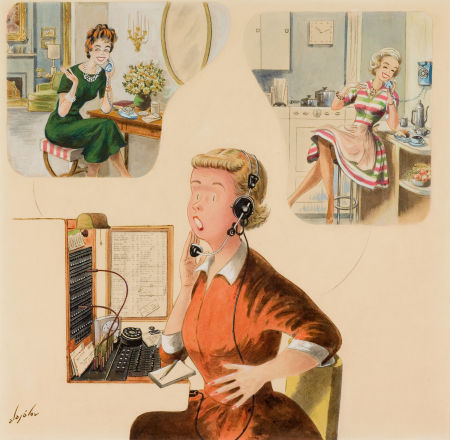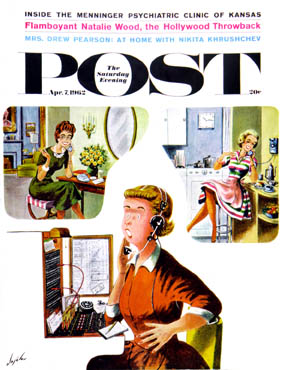"Telephone Exchange, Saturday Evening Post Cover" Lot no. 486
By Constantin Alajalov (American- 1900-1987)
1962 (Estimated)
21.00" x 20.00"
Gouache on Board
Signed Lower Left
REQUEST PRICE
PURCHASE REQUEST
Telephone Exchange, Cover of The Saturday Evening Post Magazine, April 7, 1962
Constantin Alajalov was the court artist to the Czar of Russia at the time of the Russian Revolution, barely escaping with his life before coming to America and getting a job illustrating for New Yorker magazine. He quickly adapted to the American way of life, and his cartoon-like drawings made his admiring public laugh at themselves. His many covers for The Saturday Evening Post were amusing, unique and highly collectible.
“The Telephone Exchange,” painted for the cover of The Saturday Evening Post on April 7, 1962, shows two young ladies chatting while a surprised telephone operator listens intently to learn the local gossip. In the fifty years since then, operators have been replaced by direct dialing, and gossip has been relegated to newspapers and television.
The Post described, “We hasten to point out that most telephone operators do not consider eavesdropping good form. The apartment-house switchboard girl depicted on our cover by artist Constantin Alajalov, however, evidently finds listening in to gossip fascinating —though on this occasion, downright shocking. We have only faint hope that the earful she is getting will cure her noisiness.”
(The Saturday Evening Post, April 7, 1962, p. 3)
Explore related art collections: Magazine Covers / Women as Subjects / Saturday Evening Post Covers / Drama / Comics/Cartoon / Humor / Fashion / 1960s / $20,000 - $50,000
See all original artwork by Constantin Alajalov
ABOUT THE ARTIST
Constantin Alajalov sold his first cover to The New Yorker magazine in 1926, and continued to paint a long and colorful series of satirical vignettes of American life for both The New Yorker and The Saturday Evening Post until 1962.
Alajalov was born in the Russian town of Rostov-on-the-Don. The Revolution came when he was seventeen and a student at the University of Petrograd. He survived this period by working as a government artist, painting huge propaganda pictures and portraits, and in 1921, he made his way to Constantinople, which was an international refugee haven.
Although largely self-taught as an artist, Alajalov earned a precarious living by sketching portraits in bars or painting sidewalk advertisements for movie houses. He progressed to doing murals for night clubs, taking mostly food as payment. After two years of this, he saved enough to pay his passage to America.
Once here, Alajalov resumed painting murals, in Russian night clubs, and within three years had sold that first New Yorker cover. For the rest of his career, he continued to give us a candid and humorous look at our foibles.



